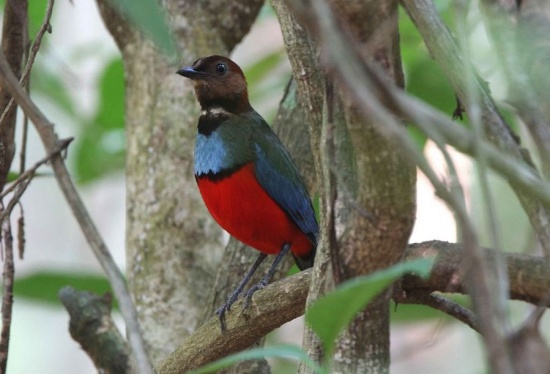- Erythropitta celebensis
Identification
16 - 18cm.
- head red-brown
- lores and supercilium dark brown
- cheeks cinnamon
- variable midcrown to nape stripe blue
- upper mantle blue
- lower mantle and back dark green
- rump and tail blue
- Deep blue upperwing-coverts,
- flight-feathers black
- primaries with variable small white spots
- lower throat and upper breast black (sometimes with white throatband)
- breast bands broad glossy blue and broad black band below
- rest of underparts scarlet
- bill black
Females are duller and more green with less blue on breast. Juveniles are dull brown above and have a dull blue rump and tail. They are paler below, have a whitish throat and a dark brown breast with white spots.
Distribution
Endemic to Sulawesi and Manterawu and Togian Islands. South East Asia: Indonesia: Greater Sundas. Locally common.
Taxonomy
This is a monotypic species.
Formerly included in Red-bellied Pitta.
Habitat
Dense primary rainforest, logged or heavily degraded forest, scrub, plantations, remnant forest patches with cultivation, bamboo groves and thickets near rivers. Often in forest on volcanic soils.
In lowlands below 1200 m.
Behaviour
Diet
Feeds on insects and their larvae, earthworms and some plant material.
Forages mainly on the ground.
Breeding
Singing males recorded on territory from January to March but season probably to October.
The domed nest is made of twigs and leaves, grass and ferns. It's mostly placed on the ground or low in scrub or a tree. Some nests were placed 10m above the ground. Lays 2 eggs.
Movements
Probably sedentary.
References
- Clements, J. F., T. S. Schulenberg, M. J. Iliff, D. Roberson, T. A. Fredericks, B. L. Sullivan, and C. L. Wood. 2015. The eBird/Clements checklist of birds of the world: v2015, with updates to August 2015. Downloaded from http://www.birds.cornell.edu/clementschecklist/download/
- Dickinson, EC, ed. 2003. The Howard and Moore Complete Checklist of the Birds of the World. 3rd ed., with updates to October 2008 (Corrigenda 8). Princeton: Princeton Univ. Press. ISBN 978-0691117010
- Gill, F and D Donsker (Eds). 2016. IOC World Bird Names (version 6.3). Available at http://www.worldbirdnames.org/.
- Del Hoyo, J, A Elliot, and D Christie, eds. 2003. Handbook of the Birds of the World. Volume 8: Broadbills to Tapaculos. Barcelona: Lynx Edicions. ISBN 978-8487334504
Recommended Citation
- BirdForum Opus contributors. (2024) Sulawesi Pitta. In: BirdForum, the forum for wild birds and birding. Retrieved 27 July 2024 from https://www.birdforum.net/opus/Sulawesi_Pitta
External Links
GSearch checked for 2020 platform.1




